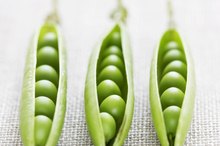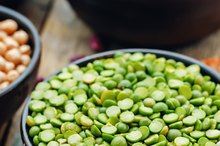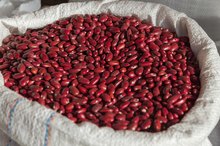What does fact checked mean?
At Healthfully, we strive to deliver objective content that is accurate and up-to-date. Our team periodically reviews articles in order to ensure content quality. The sources cited below consist of evidence from peer-reviewed journals, prominent medical organizations, academic associations, and government data.
- Harvard Medical School: Glycemic Index and Glycemic Load for 100+ Foods
- Mayo Clinic: Dietary Fiber: Essential for a Healthy Diet
The information contained on this site is for informational purposes only, and should not be used as a substitute for the advice of a professional health care provider. Please check with the appropriate physician regarding health questions and concerns. Although we strive to deliver accurate and up-to-date information, no guarantee to that effect is made.
Chick Peas & Blood Sugar
According to the American Diabetes Association chick peas serve as a diabetic super food. They are filled with nutrients lacking in the typical American diet, and they will fill you up without a lot of calories. Add chick peas to your meal planning to help keep your blood sugar levels in check.
Glycemic Index
A glycemic index ranks foods based on how much they increase blood sugar levels. To avoid drastic increases in blood sugar, opt for foods that have a low index, such as chick peas. According to Harvard Medical School, chick peas have an index of 10, which is significantly lower than other beans, including black beans, navy beans, soybeans and lentils 1. Opt for dried chick peas instead of canned ones. Canned chick peas are typically preserved in brine, which increases the index to 38.
- A glycemic index ranks foods based on how much they increase blood sugar levels.
- According to Harvard Medical School, chick peas have an index of 10, which is significantly lower than other beans, including black beans, navy beans, soybeans and lentils 1.
Fiber
List of Roughage Foods
Learn More
Fiber is listed on a food label under total carbohydrates. Carbohydrates have the most significant impact on blood sugar, but fiber actually does not raise blood sugar levels because your body doesn’t digest it. If you are counting carbohydrates to plan your meals, subtract the total amount of fiber from the carbohydrates. For diet of 2,000 calories a day, you need 28 grams of fiber. A 1-cup serving of chick peas provides you with 12.5 grams. According to the Mayo Clinic, fiber slows the absorption of blood sugar and may reduce your risk for developing type 2 diabetes.
- Fiber is listed on a food label under total carbohydrates.
- If you are counting carbohydrates to plan your meals, subtract the total amount of fiber from the carbohydrates.
Appetite Control
Chick peas help keep your appetite under control. According to the Mayo Clinic, high-fiber foods take longer to chew. Extra chewing gives your body time to signal to your brain that you are full, so you stop eating sooner and don’t overeat. The Mayo Clinic also states fiber makes a meal feel larger than it is and keeps you feeling full longer. This prevents you from reaching for an unhealthy snack between meals with a high glycemic index that will increase your blood sugar levels.
- Chick peas help keep your appetite under control.
- Extra chewing gives your body time to signal to your brain that you are full, so you stop eating sooner and don’t overeat.
Recommendations
Fiber in Refried Beans
Learn More
Chick peas are a versatile bean. Top salads with chick peas or add them to pasta and rice dishes for extra protein. Roast them with a dash of garlic salt and a touch of olive oil for a healthy snack, or puree them into hummus for a vegetable dip. Dried chick peas have a lower glycemic index than canned chick peas, but canned chick peas are more convenient. If you’re pressed for time, rinse and wash off the liquid in canned beans to eliminate the salt and preservatives.
- Chick peas are a versatile bean.
- If you’re pressed for time, rinse and wash off the liquid in canned beans to eliminate the salt and preservatives.
Related Articles
References
- Harvard Medical School: Glycemic Index and Glycemic Load for 100+ Foods
- USDA Nutrient Data Laboratory: Nutrient Data for 16057, Chick Peas (Garbanzo Beans, Bengal Gram), Mature Seeds, Cooked, Boiled, Without Salt
- Mayo Clinic: Dietary Fiber: Essential for a Healthy Diet
- Peas, green, frozen, cooked, boiled, drained, without salt. FoodData Central. U.S. Department of Agriculture. Published April 1, 2019.
- Glycemic index and glycemic load for 100+ foods. Oregon State Extension.
- Dahl WJ, Foster LM, Tyler RT. Review of the health benefits of peas (Pisum sativum L.). Brit J Nutr 2012;108 Suppl 1:S3-10. doi:10.1017/S0007114512000852
- Appleby PN, Key TJ. The long-term health of vegetarians and vegans. Proc Nutr Soc. 2016;75(3):287-93. doi:10.1017/s0029665115004334
- Busnelli M, Manzini S, Sirtori CR, Chiesa G, Parolini C. Effects of vegetable proteins on hypercholesterolemia and gut microbiota modulation. Nutrients. 2018;10(9). doi:10.3390/nu10091249
- Centers for Disease Control and Prevention. Eat more, weigh less?. Updated May 15, 2015.
- American Academy of Allergy, Asthma & Immunology. Pea allergy and peanut allergy. Updated June 20, 2018.
- Peas. University of Illinois Extension Watch Your Garden Grow. Updated 2020.
- Snacks, peas, roasted, wasabi-flavored. FoodData Central. U.S. Department of Agriculture. Published April 1, 2019.
Writer Bio
Michelle Fisk began writing professionally in 2011. She has been published in the "Physician and Sports Medicine Journal." Her expertise lies in the fields of exercise physiology and nutrition. Fisk holds a Master of Science in kinesiology from Marywood University.









